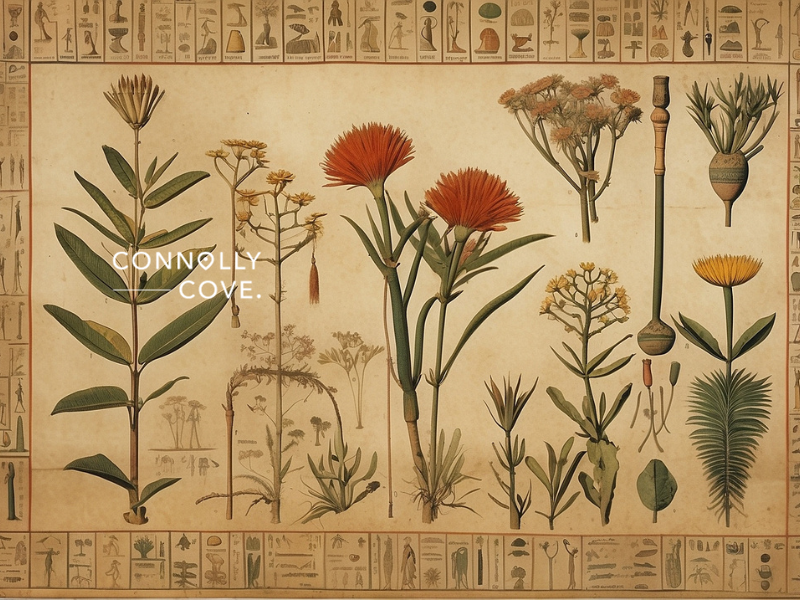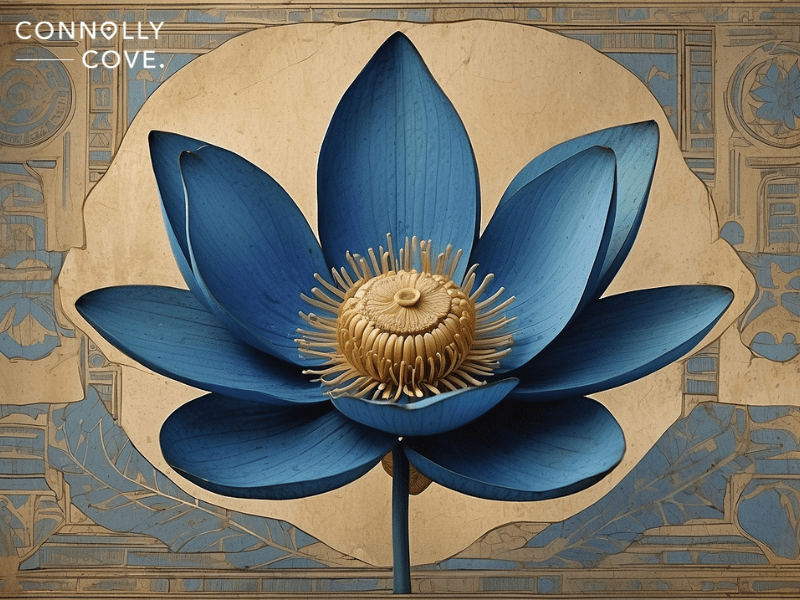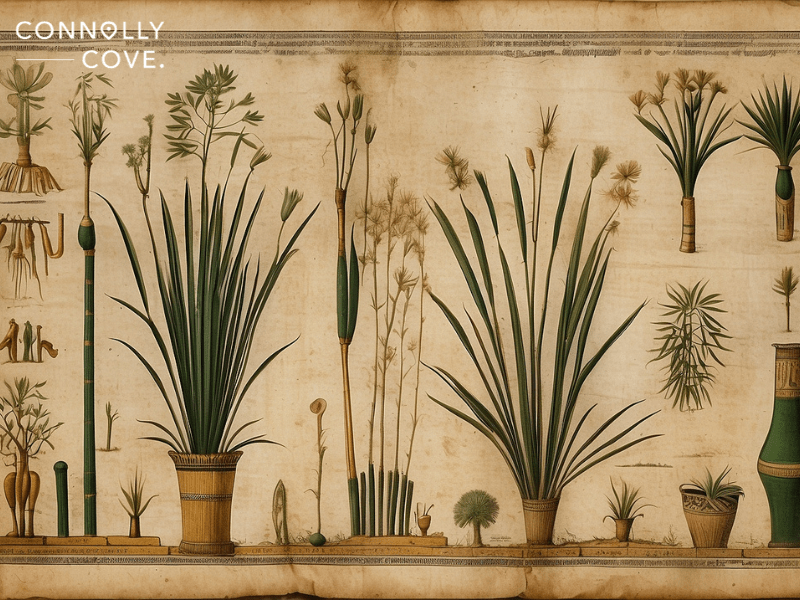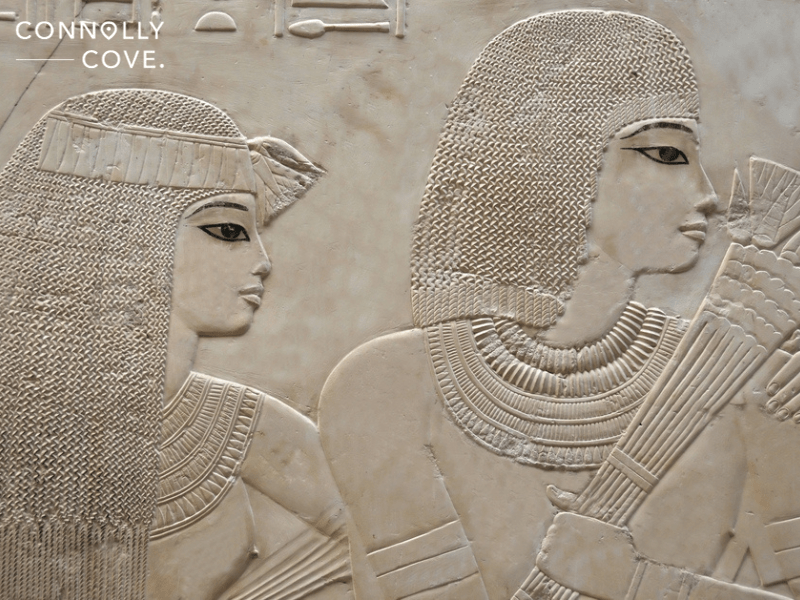An Exploration of Ancient Egyptian Flora

Updated On: April 23, 2024 by Raghda Elsabbagh
The civilisation of ancient Egypt, with its grand pyramids, elaborate temples, and rich cultural heritage, is a subject of fascination for historians and enthusiasts alike. One of the often-overlooked aspects of this remarkable civilisation is its deep connection with nature, specifically the diverse range of ancient Egyptian flora.
In ancient Egypt, flowers and plants held immense cultural significance. They played a vital role in various aspects of daily life. They had medicinal applications, agricultural importance, and an impact on art, trade, and society.
Let’s stroll down the Nile and step into a petal-packed adventure to uncover the secrets of ancient Egyptian flora.
Table of Contents
Botanical Diversity in Ancient Egypt
The ancient Egyptians lived in a land blessed with an impressive diversity of ecosystems due to the geographical and climatic variations across the Nile Delta, Nile Valley, and the desert. These regions provided a unique and fertile ground for a vast range of plant species to flourish. The ancient Egyptians, in turn, recognised and utilised this diversity for various purposes.
Overview of the Geographical Regions of Ancient Egypt
Ancient Egypt, often named the “Gift of the Nile,” was a civilisation that thrived along the banks of the Nile River. The geographical boundaries of ancient Egypt encompassed a unique and diverse landscape. It was divided into two major regions: Upper Egypt, which stretched southward from the Nile Delta to roughly the area of modern-day Aswan, and Lower Egypt, which encompassed the Nile Delta in the north.
This geographical division, defined by the Nile River, played a crucial role in shaping the botanic diversity of ancient Egypt. While the Nile River was the lifeblood of the civilisation, the surrounding regions, from the fertile Nile floodplains to the arid deserts, offered an array of environments for diverse plant life to thrive.
The Diverse Ecosystems and Habitats in Egypt
The diverse ecosystems in ancient Egypt were a product of its geographical variations. From the shores of the Mediterranean Sea, where the salty breeze mingled with the desert dust, to the coastal marshes, there was no shortage of habitat variety.
The Nile Delta, a lush and fertile region in Lower Egypt, referred to as the “Black Land”, was characterised by its nutrient-rich dark soil, making it ideal for agriculture. This unique geographic blessing allowed the ancient Egyptians to establish a stable and prosperous civilisation. The entire Egyptian economy and society revolved around agriculture, making it not only a source of sustenance but a fundamental pillar of their existence.
In contrast, Upper Egypt was more arid, with desert landscapes that extended into modern-day Sudan. The deserts of Egypt, including the Western Desert and the Eastern Desert, offered a unique set of flora adapted to harsh conditions, such as acacia trees, thorny shrubs, and drought-resistant plants. In the oases scattered throughout these deserts, lush and vibrant amid all that sand, date palms, figs, and other fruit-bearing plants provided sustenance for those who inhabited these remote regions. And let’s not forget the wadis, those dry riverbeds that could burst into life with the sweet kiss of rain, showing that even in the driest of places, life found a way.
The Red Sea coast was another distinct ecosystem, home to unique plant species adapted to its arid and salty environment. The varying climates and landscapes of ancient Egypt gave rise to a remarkable diversity of plants, each adapted to its specific ecological niche.
Importance of the Nile River in Supporting Plant Life
The Nile River was not only the lifeblood of ancient Egypt but also the primary factor that sustained the rich plant life in the region. The Nile experienced a predictable yearly flood cycle that brought essential nutrients and moisture to the floodplains. The inundation of the Nile deposited nutrient-rich silt, rejuvenating the soil and ensuring its fertility for agriculture. It was like Mother Nature’s way of restocking the pantry. The annual flooding from heavy rains in the Ethiopian highlands allowed ancient Egypt to feed itself and thrive.
Without the Nile’s replenishing waters, the agricultural productivity of ancient Egypt would have been severely compromised. This close connection between the Nile River and plant life was fundamental to the civilisation’s prosperity, symbolising the interdependence of nature and human culture in ancient Egypt.
Petal Power: Sacred and Symbolic Plants in Ancient Egypt
Among the most iconic and revered plants in ancient Egypt were the lotus and the papyrus, which held symbolic significance in Egyptian culture and extended beyond mere aesthetics. These plants were deeply woven into ancient Egyptian society‘s religious and mythological fabric.
The Lotus in Ancient Egyptian Mythology

The blue lotus (Nymphaea caerulea) and the white lotus (Nymphaea lotus) were not only remarkably magnificent; the lotus symbolised rebirth, renewal, purity, and the promise of eternal life because it would close up at night and bloom again in the morning. If you’re a night owl, you can maybe take some lessons from the lotus on starting fresh each day.
The image of the lotus rising from the murky waters of the Nile, unfurling its petals to reveal its pristine beauty, symbolised the journey of the soul from the mortal world to the afterlife. This concept was particularly associated with the sun god Ra, who was believed to have emerged from a giant lotus that opened its petals at dawn. This mythological connection between the lotus and the sun underscores themes of creation, rejuvenation, and the daily cycle of life.
The Papyrus Plant in Ancient Egyptian Mythology

Papyrus was a versatile plant with various uses. Papyrus (Cyperus papyrus) was an essential tool for education, communication, and the preservation of knowledge. It was famously used to create writing material, making it a crucial resource for recording information through scrolls, documents, and texts.
Papyrus grew abundantly in the Nile Delta marshes, was emblematic of the northern part of Egypt, and symbolised the unification of Upper and Lower Egypt. This unification represented the cyclical nature of life and death, emphasising the idea of rebirth and the continuity of the kingdom. The ancient Egyptians believed that incorporating these plants into their religious and cultural practices would ensure their own spiritual rebirth in the afterlife, perpetuating the cycle of existence.
You see, these plants were all about the circle of life, just like Simba in The Lion King. With its daily cycle of blooming and closing at night, the lotus was like hitting the reset button every day. When it came to the afterlife, papyrus was the real hero. They believed using papyrus in the Book of the Dead would help guide the departed souls through the treacherous journey to the afterlife. It’s like giving your GPS a spiritual upgrade for the ultimate road trip.
Use of Lotus and Papyrus in Religious Rituals and Iconography

Ancient Egyptians weren’t just into mummifying cats and building giant pyramids; they were also big on religious ceremonies. The lotus and papyrus played starring roles in religious rituals and iconography. The use of these plants in religious iconography created a connection between the physical and spiritual realms, reminding the ancient Egyptians of the perpetual cycles of life and death, creation and rebirth.
In temples and tombs, depictions of these plants were ubiquitous. The motifs of the lotus and papyrus adorned the columns, walls, and even thrones of pharaohs and deities. It’s like having your favourite band’s posters all over your room; the ancient Egyptians were showing off their plant pride!
Priests and priestesses would often be depicted holding lotus flowers in temples, emphasising purity and connection to the divine. In religious ceremonies, lotus flowers and papyrus were offered to the gods as symbols of purity and renewal.
Medicinal and Herbal Uses of Ancient Egyptian Flora
The ancient Egyptians were pioneers in medicine, and their knowledge of plants and medicinal properties was highly advanced for their time. Let’s open the dusty pages of history to reveal the ancient secrets of healing in the land of the pharaohs.
Overview of Ancient Egyptian Medical Practices
The ancient Egyptians deeply understood the healing properties of plants, which had a role in their medical practices, serving as remedies for a wide range of ailments and injuries. Their medical knowledge was a testament to their keen observations of the natural world and its potential for therapeutic use.
Ancient Egyptian medicine was a holistic approach that combined magical and practical elements, emphasising maintaining the balance of the body’s vital energies. Their medicine was like a witch’s brew of herbs, prayers, and incantations.
What Plants Were Used for Medicinal Purposes?
Some of the most notable medicinal plants included the opium poppy (Papaver somniferum), which was used for pain relief and as a sedative. Aloe vera (Aloe barbadensis miller), known for its soothing and healing properties, was used to treat burns, skin irritations, and digestive issues.
The mandrake (Mandragora officinarum), with its large, fragrant, and conspicuous flowers, was used as an anaesthetic and for its potential psychoactive effects. It was also associated with healing and fertility in ancient Egypt.
If the Pharaohs were feeling the itch for something spicy, garlic (Allium sativum), the pungent guardian of their pantries, was their go-to plant. Garlic was believed to have protective powers and was used as a potent antibiotic and a natural mosquito repellent. How about that? The ancients knew how to keep those pesky critters at bay while adding a little zing to their culinary creations.
The coriander was used to treat tummy troubles and as an aphrodisiac. The Egyptians were spicing up their love life while curing indigestion! Depending on the specific ailment being treated, these plants were administered in various forms, including poultices, infusions, and ointments.
Role of Priests and Physicians in Healing with Ancient Egyptian Flora
The knowledge of medicinal plants was not confined to a select few but was widely disseminated in ancient Egyptian society.
Priests, revered for their wisdom, often played a prominent role in administering medical treatments. They were responsible for maintaining the health of the pharaoh, the ruling elite, and the general population.
Physicians, another specialised group, were responsible for diagnosing and treating various illnesses and injuries. They often worked alongside priests and deeply understood medicinal plants and their applications. Combining religious and practical knowledge ensured a holistic approach to healing, acknowledging both the physical and spiritual aspects of well-being.
The Ebers Papyrus and Its Significance in Documenting Ancient Egyptian Medicine
The Ebers Papyrus is one of the most important and well-preserved medical texts from ancient Egypt, dating back to around 1550 BCE. This papyrus, which is over 20 metres long, is their version of a medical encyclopedia. It provides a comprehensive record of ancient Egyptian medical knowledge, including the use of medicinal plants.
It documents over 700 remedies and prescriptions for various ailments, showcasing their deep understanding of the healing properties of nature. The Ebers Papyrus not only lists the plants and ingredients used but also provides detailed instructions on their preparation and application, serving as a remarkable testament to the advanced state of ancient Egyptian medicine. It’s simply a goldmine for historians trying to decode the secrets of ancient Egyptian medicine.
Miscellaneous Uses of Different Flowers in Ancient Egypt
Here are some of the uses of various flowers in ancient Egypt:
- The white lily (Nymphaea lotus) was associated with purity and fertility. Lilies adorned ceremonial crowns and wreaths. They were also used in funerary rituals, symbolising the hope for rebirth and eternal life.
- Narcissus (Narcissus tazetta), known for its fragrant scent, was used to create scented oils and perfumes. It was also used in various offerings and rituals dedicated to gods and goddesses.
- The iris (Iris germanica) was associated with the goddess Iris, the messenger of the gods. It symbolised communication and linked the mortal world to the divine realm. Iris flowers were used as offerings in religious ceremonies and as decorative elements in temples and tombs.
- Although not native to Egypt, roses (Rosa) were imported and cultivated in ancient Egyptian gardens. They symbolised love and beauty. Roses were used in cosmetics, perfumes, and as decorative elements in garlands.
- Frankincense (Boswellia sacra) wasn’t a flower but a resin from the Boswellia tree. In ancient Egypt, it was used in religious ceremonies, offering sweet-smelling incense to the gods. Its aromatic smoke was believed to help bridge the gap between the earthly and divine realms.
- The acacia (Acacia nilotica) tree was used for various purposes, including its fragrant gum. This gum was used in the embalming process and as an offering in funerary rituals. Acacia wood was also employed in the construction of coffins and furniture.
- The leaves and petals of the henna (Lawsonia inermis) plant were used to produce a reddish-brown pigment. Egyptians used henna paste to dye hair, skin, and nails for both cosmetic and ritualistic purposes.
- Saffron (Crocus sativus) threads, derived from the crocus flower, were used as a spice, perfume, and natural dye to produce a bright yellow colour. This pigment was employed in textiles, including those used in ceremonial and religious garments. Saffron was considered a luxurious and valuable commodity.
- Cyclamen (Cyclamen persicum) flowers were used as decorative elements in gardens and ornamental motifs in art and architecture for their exquisite beauty.
- Jasmine (Jasminum sambac), with its sweet fragrance, was admired for its aroma. It was used in perfumes and oils and as a garden decorative plant.
Nature’s Palette: The Use of Flower-Derived Pigments in Ancient Egyptian Art
- Myrtle (Myrtus communis) was cultivated for its fragrant leaves and flowers, which were used in perfumes and wreaths. Myrtle wreaths symbolised love and purity and were worn by brides. Myrtle leaves and berries could be used to create a green pigment. This natural green was employed in various artistic and decorative applications, from painting to jewellery.
- Safflower (Carthamus tinctorius) petals created a bright red and orange pigment. The colour extracted from the safflower served as a natural dye for textiles, cosmetics, and decorative art. It added colour to clothing, jewellery, and temple decorations.
- Indigo (Indigofera tinctoria), obtained from the indigo plant’s leaves, was used to create a deep blue dye. It was a valuable pigment in ancient Egypt employed in dyeing textiles, creating ornate murals, and decorating pottery.
- Madder (Rubia tinctorum) root was used to obtain red and pink pigments. These colours were applied in various artistic and decorative contexts, such as painting tombs and frescoes and creating pottery.
- Alkanet (Alkanna tinctoria) roots and flowers produced a red to purplish dye. This pigment was utilised in cosmetics, fabric colouring, and even as an ingredient in perfumes. It added a touch of elegance to both personal adornments and interior decorations.
- Weld (Reseda luteola) was a plant whose leaves and stems were used to extract a yellow pigment. It was used to dye textiles and provided the yellow hues seen in various decorative items and artwork.
- Onion (Allium cepa) skins and bulbs were used to produce a range of colours, from yellows to reds. These pigments were used in dyeing textiles, decorating pottery, and painting murals.
So, in a nutshell, the ancient Egyptian garden was a place of wonder, mystery, and a dash of ‘mummified’ humour. They knew how to make the most of their green friends, turning them into symbols of life, death, and everything in between.
Now, the next time you see a flower or plant, you’ll know there’s more to it than meets the eye and remember those ancient Egyptians who knew how to make the most out of what Mother Nature provided.






